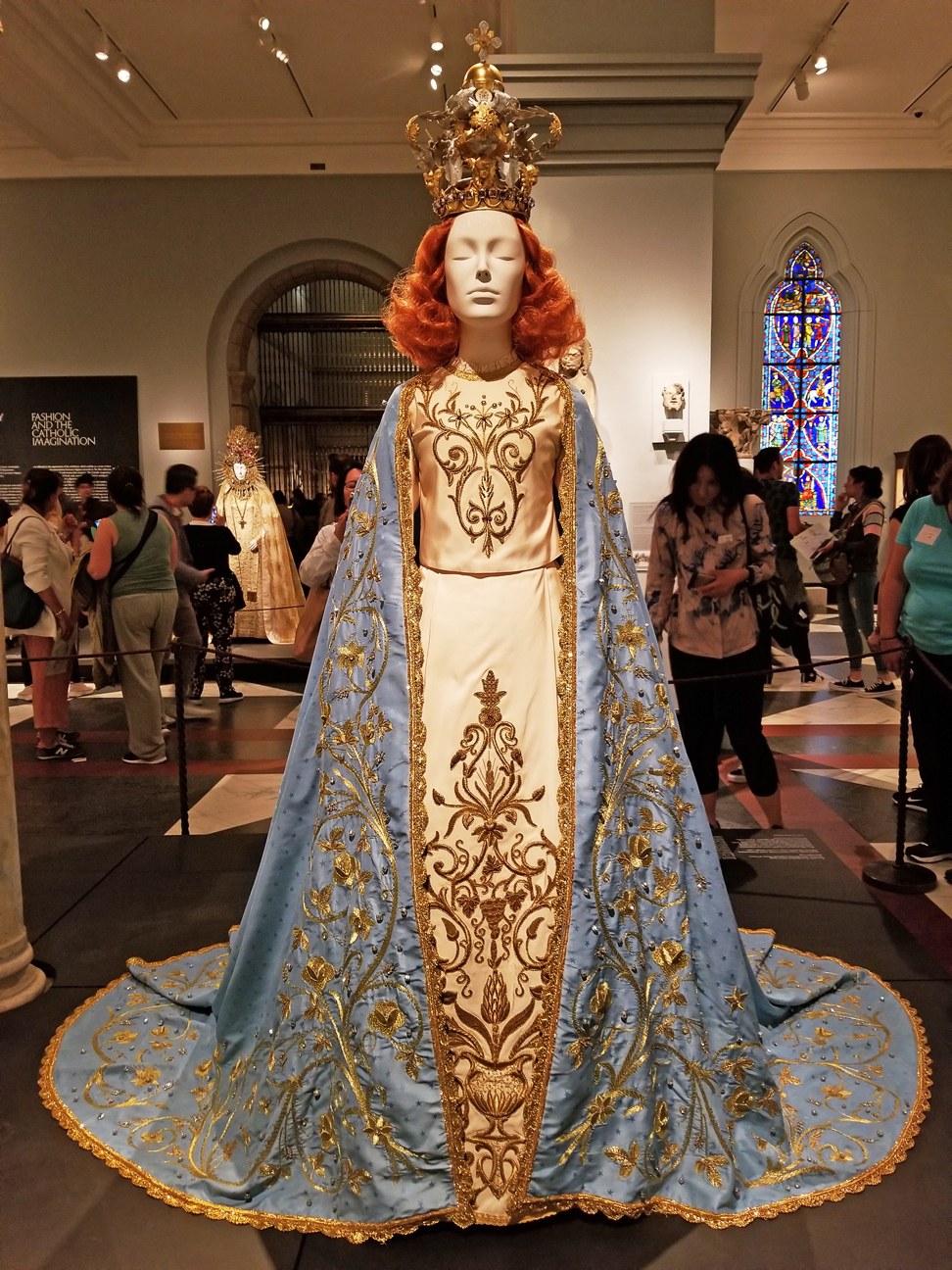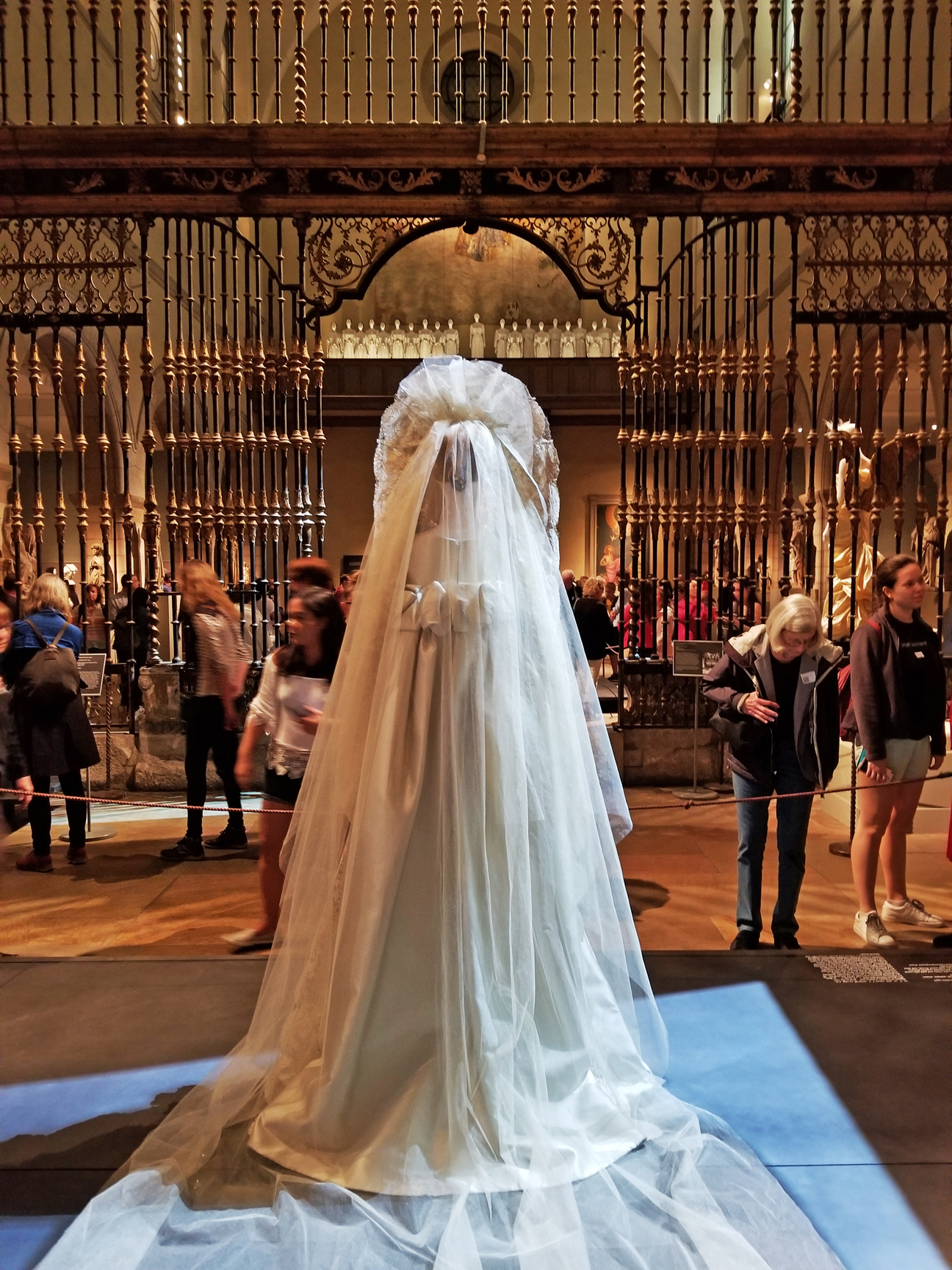Heavenly Bodies at the Met

When a cheap fare for Madrid popped up for the general dates I'd blocked in June, I jumped on it. Of course, cheap fares are cheap for a reason - this one included a 12-hour layover in NYC. Lucky for me, living in New York for several years means being able to navigate to and from the airport easily and inexpensively, and knowing how to kill time in the city. Originally, I planned to finally check out the Chelsea Highline, but then I saw that the Met had an amazing exhibit currently running, and decided to do that instead.

'Heavenly Bodies' opened in May (you may remember some of the incredible get-ups at this year's Met Gala) and is spread across both of the Metropolitan Museum of Art's locations, the main museum at 5th Avenue and the Cloisters, uptown near Fort Tryon Park. I didn't make it to the Cloisters this time, which is a shame, because the brilliance of this exhibit is how the Met has used its Medieval collection to highlight religious, historical, and artistic connections - and the Cloisters *are* the Met's Medieval masterpiece.


That said, what was on the display at the Met 5th Avenue was pretty incredible as well. The only exhibit I've seen there that tops it was Alexander McQueen in 2011. A few things have changed since I lived in the city - the Met now charges full admission ($25) for out of town visitors. Over the years, the Met has sort of become my spiritual home in New York, and paying so much to go home seems cruel. I paid $5 as I usually do and was glad I still carry my Brooklyn Library card in my wallet.

Within the museum, there are at least three areas that host parts of the show. The first are the adjacent Medieval and Byzantine collections. The second is the Lehman Collection. The third is the Anna Wintour Costume Institute, where actual Catholic vestments are on display. (No photos were allowed here - see this post by the Creative Adventurer for a great run-down on this section of the exhibit.) I was struck by the sheer excess of some of the Papal tiaras. It was a feeling I'd experience again many times in Spain, one of the hypocrisy of a religion that seeks and hoards riches while claiming to follow the words of someone who said, "It is easier for a camel to go through the eye of a needle, than for a rich man to enter into the kingdom of God". Though that's not to say I don't also enjoy these things, from a purely aesthetic point of view.




Aside from the fashion itself being incredible, the way the pieces are displayed really makes this exhibit. Surrounded by Medieval art and architecture (which in itself is almost 100% religious) the fashion gains immediate context and can become richer or more superficial depending on the feeling of the viewer - which is kind of ingenious. In the Medieval gallery, the glorious choir screen from Valladolid serves as a sort of pearly gates between fashion inspired by earth-bound nuns and priests, and the more celestial realm of saints and angels.



Reading a placard by one of the show stoppers, I was bummed to discover it had been created by John Galliano, who is a fairly horrible person. It is interesting to see what an inspiration religion is to these mostly European-based designers, a theme that was also present in the McQueen show. (At least one piece made it into both exhibits.)

Something else that occurred to me was how many of the pieces would have felt right at home in a fairy tale. A Jean Paul Gaultier piece, exhibited in a glass case in a manner reminiscent of incorruptible saints, could have been Snow White or Sleeping Beauty. Angels wings could easily belong on fairy queens.





After seeing the exhibit, I made two stops that were relevant to my impending trip. The first was in the Lehman Collection, almost accidentally. I peeked into a room near the bit of 'Heavenly Bodies' located there, and remembered there were a couple of El Greco's nearby. So I visited. Taking time to look at the painting of Christ, my attention was drawn to the specificity of his crown of thorns. It became a bit of an obsession for me as I made my way through the master's artwork in Spain, as I'll detail in a later post.

I also stopped by the Temple of Dendur, the Met's incredible Roman-era Egyptian temple. As the Aswan Dam was built, Egypt gave away four minor temples to countries that helped move and preserve some of Egypt's greater historic sights, like Abu Simbel. Dendur is arguably the grandest of the four - its only competition is the Templo Debod, which was placed outdoors in one of Madrid's parks. I planned to visit it on my last day in Madrid, as I love a good bookend to a trip.

By this point, I was feeling pretty awful - hungry, light-headed, crampy, and still not entirely over an awful cough and cold I'd contracted during the last two weeks of school. A late lunch at Le Pain Quotidien helped with the first two problems. Back at JFK, I discovered the flaw in my layover plan - the Air Europa ticket counter didn't open until 7:00 pm, leaving me to sit on the cold and dirty floor of the departures hall till I could get my boarding pass.

About half an hour in, I decided to go sit in the AirTrain station two floors down, as they actually have seats. I took a bit of time to change into comfy clothes for the flight ahead. In the end, the Air Europa counter opened closer to 6:00 than 7:00. For a budget airline, it wasn't half bad. And as a soccer fan, I appreciated the name of the plane that would take me to Madrid.


Comments
Post a Comment